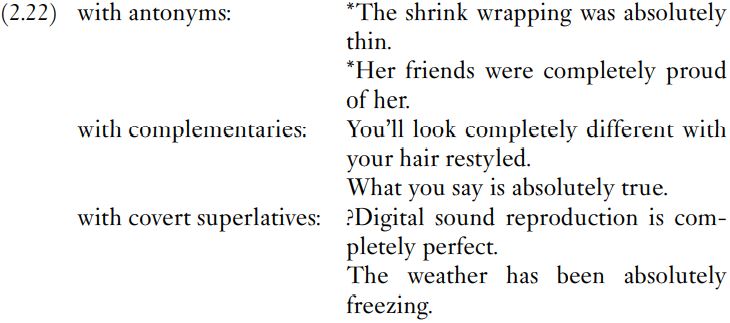


 Grammar
Grammar
 Tenses
Tenses
 Present
Present
 Past
Past
 Future
Future
 Parts Of Speech
Parts Of Speech
 Nouns
Nouns
 Verbs
Verbs
 Adverbs
Adverbs
 Adjectives
Adjectives
 Pronouns
Pronouns
 Pre Position
Pre Position
 Preposition by function
Preposition by function 
 Preposition by construction
Preposition by construction
 Conjunctions
Conjunctions
 Interjections
Interjections
 Grammar Rules
Grammar Rules
 Linguistics
Linguistics
 Semantics
Semantics
 Pragmatics
Pragmatics
 Reading Comprehension
Reading Comprehension|
Read More
Date: 2024-08-25
Date: 2023-04-26
Date: 2023-12-01
|
Constructions with adjectives
Gradability
The comparative forms discussed in Section 2.2.4 are an aspect of something more general: many adjectives (and also adverbs, though they are ignored here) are gradable, which is to say that the language has ways of expressing different levels or degrees of the qualities that they denote.
Examples are given in (2.18), with the relevant indicators of gradability in italics.

The adjectives in the examples given in (2.18) are all members of antonym pairs. They denote regions towards either end of scales. For instance, there is a scale of thickness, with thick denoting values towards one end, thin denoting values towards the other end, and a region in between that is neither thick nor thin. Interestingly, there is frequently one member of each pair that signals bias regarding the answer if it is used in asking questions about positions on the scale, whereas the other member of the pair is used in asking unbiased questions. See the short conversations in (2.19).

The questions with thin (2.19a, b) show a bias: the senders, A and C, expect answers that place the piece of wood somewhere in the ‘thin’ region. That is why it is natural for speaker D, who is faced with a thick piece of wood, to first negate C’s expectation by saying “It’s not thin”. But the unbiased question with thick (2.19c, d) simply enquires where the piece of wood is on the thin–thick scale, without bias towards an answer in the thick region. Thus, there is no pressure for speaker H to begin the reply by saying “It’s not thick”.
The members of complementary pairs (same–different, right–wrong and so on) are resistant to grading. See the examples in (2.20).

Superlatives (such as best and fastest) and covert superlatives (such as freezing) denote extreme ends of scales. Some examples are given in (2.21) of their tendency towards non-gradability.

There are some adverbs that will go with both complementaries and covert superlatives, but not with most ordinary antonyms. The “maximizers” absolutely and completely are among these adverbs. Some examples are presented in (2.22).

|
|
|
|
دخلت غرفة فنسيت ماذا تريد من داخلها.. خبير يفسر الحالة
|
|
|
|
|
|
|
ثورة طبية.. ابتكار أصغر جهاز لتنظيم ضربات القلب في العالم
|
|
|
|
|
|
|
سماحة السيد الصافي يؤكد ضرورة تعريف المجتمعات بأهمية مبادئ أهل البيت (عليهم السلام) في إيجاد حلول للمشاكل الاجتماعية
|
|
|